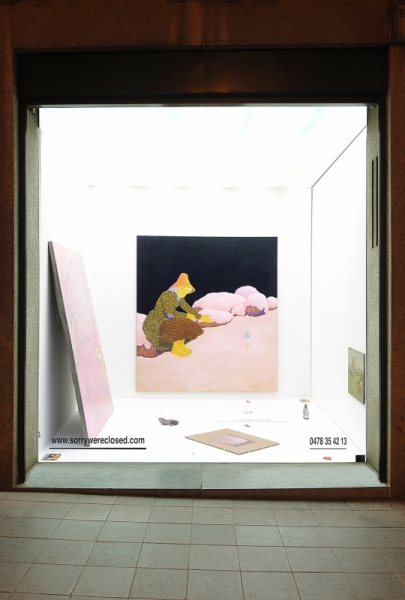
About
Uwe Henneken
Ralf Dereich
Camel Toe
08.04.11 → 20.05.11
Uwe Henneken
Using his extraordinary pictorial language drawn from childhood and the unconscious repertoire of mythical images fixed in collective memory, German artist Uwe Henneken makes paintings and sculptures based on lore that has been handed down. The forest has long been associated with a sense of German national identity, from the dense woods in early German Renaissance paintings to the ubiquitous forest in tales of the Brothers Grimm and the shadowy woodland and lone oak in the allegorical paintings of the German Romantics. Although Henneken’s sylvan settings are often borrowed from their Romantic or Symbolist predecessors, their allegorical resonance is tweaked into the realm of the uncanny by the appearance of vibrant, unnatural colors and weird, quasi-comical, other-worldly interlopers. While conscious citation, intervention and recontextualization are practised strategies in recent art, the unfashionable mythical or primitive subjects, not to mention an apparent dabbling in the spiritual, leave Henneken’s paintings admirably difficult to categorize.
— HM
Ralf Dereich
Courtesy CruiseCallas Gallery - Berlin
In conversation with the French writer Charles Juliet, Samuel Beckett said in 1977: “Negation is no more possible than affirmation. It is absurd to say that something is absurd. That‘s still a value judgement. It is impossible to protest, and equally impossible to assent. You have to work in an area where there are no possible pronouns or solutions, or reactions, or standpoints - that‘s what makes it so diabolically difficult.“
Samuel Beckett was inspired by the work of his friend, the Dutch painter Bram van Velde, who Ralf Dereich also names as a reference point for his own work in interview. However Dereich’s work is situated much closer to what Beckett expresses in his quote, than to American Abstract Expressionism, which was likewise strongly influenced by van Velde’s work, and from which Dereich clearly distances himself.
On first glance there appears to be much common ground between the art of the ‘50s and ‘60s andDereich’s works: his abstract oil paintings extend blurrily and without defi ned outlines across the canvas in an all-over manner. The pictorial architecture, which is composed from simple elements, directs attention towards the materiality and expression of colour and line. Dereich, though, rejects the spirituality of a Rothko or Pollock’s ways. As we hear in Beckett’s quote, for him it isn’t about an inherent clash with the outside world, be it representational or confrontational. Only the expressive capability of pure painting, the belief in painting itself is of central importance. This, above all, appears noteworthy when you take a look at his contemporaries’ work: with his art-for-art’s-sake approach, centred around the individual artist, Dereich creates a jumping-off point from the treadmill of the postmodern view of art. Dereich compares the act of artistic creation with playing music, relating especially to Miles Davis’ jazz, which lies far from any easy categorisation or pigeonholing. Davis saw in the spontaneous music of the moment the quintessence of jazz. In the same way Dereich carves out his own approach rather thanadhering to existing concepts.
The central moment in the relationship of the work with the instant of its creation is refl ected in Dereich’s prolific output and is demonstrated materially in his canvases, which are usually displayed still wet. The works shown by Dereich in “Oilcooking” are also all brand new, from 2009.
They all connect the fi rst act of execution to a continuous meandering line over the canvas, which, right up to their completion, is the defi ning element of all these works. Dereich aims at having the picture in his grasp from the very beginning. The creamy texture of the paint is noticeable and this impression is underlined through the pastel colours. Next to some darker works in toned down blue-blacks and greys, white, light blue, dark red and salmon pink predominate. In “Cream”, 2009, a small format image in red and white, the following of musical procedure becomes especially clear: the defi ning red line, which is drawn in loops over the canvas, appears as a fundamental linear structure, which is then subject to further overpainting, interruptions and blurring, all of which themselves appear as modulation of a vocal line or melody. Like an instrument with a small line to play, discreet splashes of colour, sometimes sprayed or sometimes in thick running drips, work as a counterpoint, interrupting the linear structure and completing the rhythm.
Dereich says his work is “the sound of eye and mind as parable of the people in the world.”